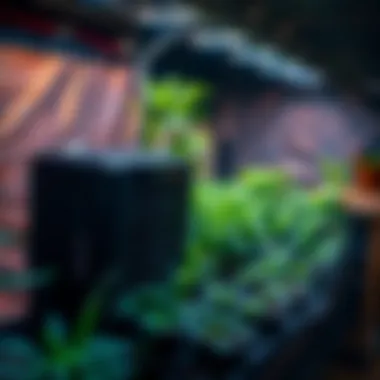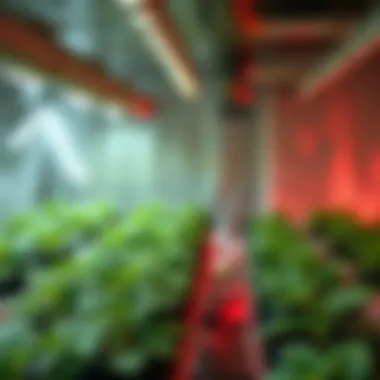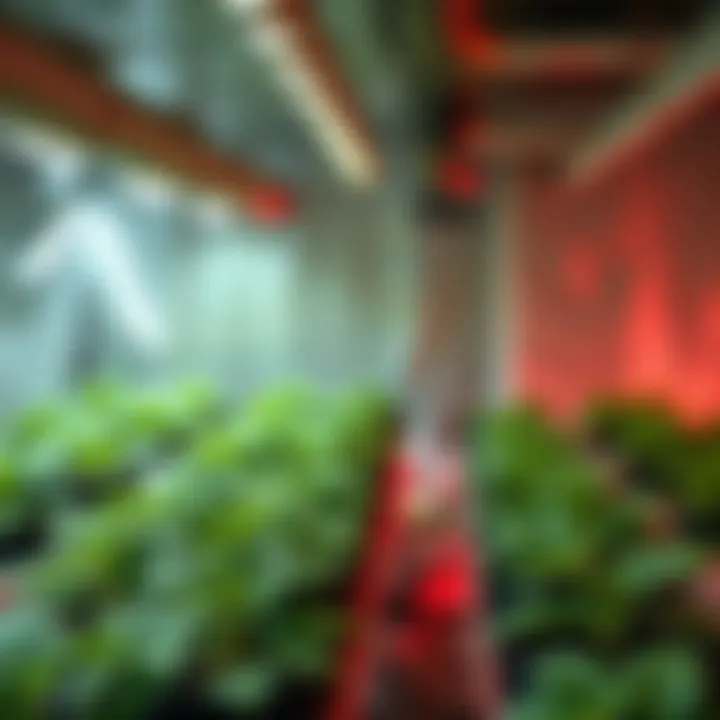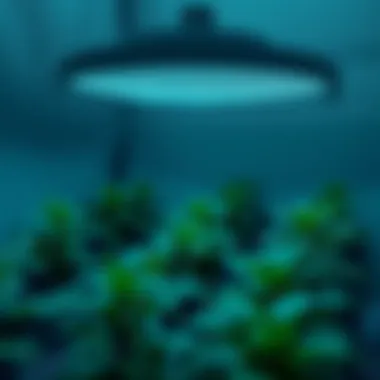Understanding Air Purifiers for Grow Tents


Intro
In the ever-changing realm of indoor gardening, air quality is paramount. Grow tents have become a staple for farmers and enthusiasts wishing to cultivate plants with precision. Within these enclosed environments, the role of air purifiers is not to be underestimated. They serve as guardians of the atmosphere, ensuring that plants thrive instead of merely surviving.
This article dives deep into the essentials of air purifiers for grow tents. Why are they important? We will explore what makes equipment like this a necessity for optimal growth conditions. From types of purifiers to understanding air circulation and its implications on plant health, we will cover a lot of ground.
Securing a healthy environment for plants doesn’t just hinge on watering and light. Air filtration contributes significantly to growth, and knowing how to leverage the right tools can be the difference between a thriving garden and a dismal one.
As we embark on this journey, the goal is to empower growers with the knowledge to enhance their endeavors, ensuring that every leaf unfurls in its best possible form.
Understanding Grow Tents
Understanding grow tents is fundamental for anyone serious about indoor gardening. These enclosed structures provide a controlled environment which can significantly enhance plant growth and health. When one decides to cultivate plants indoors, grasping the nuances of grow tents helps prevent common pitfalls associated with indoor gardening.
Defining the Grow Tent
A grow tent is basically a portable greenhouse made of durable materials like reflective mylar or canvas that sits atop a sturdy frame. Designed to create a controlled environment, these tents are a crucial part of indoor gardening setups. They come in various sizes, catering to different growing needs, from small personal setups to larger commercial operations. The reflective surfaces inside help maximize light efficiency, while the enclosure keeps temperature and humidity levels stable, which are key elements for successful plant growth.
Advantages of Indoor Growing
Indoor growing has several perks that make it a popular choice among both amateur and seasoned growers. Here are some notable advantages:
- Controlled Environment: Growers can tweak lighting, temperature, and humidity levels, mimicking optimal growing conditions all year round.
- Space Utilization: For those lacking outdoor space, grow tents provide a flexible option. They fit in garages, basements, or even spare rooms.
- Pest Management: Indoor setups allow for better pest control since plants are shielded from external pests and diseases.
- Year-Round Production: With the right setup, one can cultivate plants irrespective of the season, thus maximizing yield.
This flexibility can be a game changer, particularly when aiming for consistent crop cycles and maximizing return.
Common Issues in Grow Tents
While grow tents present a goldmine of opportunities, they aren't without their challenges. The following list highlights common issues that growers might face:
- Air Quality Concerns: Poor air circulation and contamination can hinder plant growth. This is where air purifiers come into play, aiding in maintaining optimal air quality.
- Temperature Fluctuations: If not properly managed, the temperature inside the tent can swing dramatically, leading to stress for plants.
- Humidity Levels: Maintaining the right humidity is critical. Excess moisture can lead to mold and mildew, while too little can cause dehydration.
- Light Management: Overexposing plants to light can be just as detrimental as insufficient lighting.
Understanding these issues allows growers to make informed decisions regarding their setups and often leads to the integration of solutions like air purifiers.
"An ounce of prevention is worth a pound of cure" — this adage rings especially true in the world of indoor gardening.
The Importance of Air Quality
In the realm of indoor gardening, particularly within grow tents, the significance of air quality cannot be overstated. Without a doubt, good air quality establishes the very foundation for healthy plant growth and sustainable cultivation practices. Plants, much like humans, require a balanced environment to thrive. Air quality influences several critical factors, including nutrient uptake, photosynthesis efficiency, and overall plant health.
Role of Air Quality in Plant Health
Air quality directly impacts the physiological processes of plants. For instance, when air is rich in carbon dioxide, plants can perform photosynthesis effectively. This process is essential for converting light energy into sugars, thus fueling growth. Conversely, stale or contaminated air can lead to reduced photosynthesis, stunted growth, and poor yield.
Moreover, oxygen plays a vital role in the respiration of plants. Without adequate oxygenation in the grow tent, plants may struggle to absorb water and nutrients from the soil. It’s akin to trying to breathe in a crowded room—limited airflow can make even the toughest plant feel suffocated.
Here’s how air quality contributes to plant health:
- Nutrient Uptake: Better air flow enhances nutrient absorption through root systems.
- Photosynthesis: High CO2 levels promote this essential process for growth.
- Respiration: Oxygen-rich air aids in the respiration process, enabling energy production.
Maintaining a healthy air quality is essential for ensuring that plants grow to their full potential.
Effects of Poor Air Quality
Poor air quality can manifest in several detrimental ways. For instance, when there are high levels of pollutants or allergens, such as dust, mold spores, or chemical residues, plants may display symptoms like yellowing leaves, wilting, or even stunted growth. Furthermore, indoor gardens can become breeding grounds for pests, exacerbated by inadequate air circulation. If left unchecked, these factors can lead to a full-blown catastrophe, undermining months of careful cultivation.
More critical repercussions include:


- Disease Development: Stagnant air can contribute to the growth of mold and mildew.
- Pest Proliferation: Poor air quality attracts unwanted insects.
- Nutrient Imbalance: Inability to absorb nutrients increases the vulnerability of plants.
The effects can spiral quickly, turning a promising grow tent into a battleground of crises.
Airborne Contaminants to Consider
As an indoor gardener, you must be aware of the various airborne contaminants that could jeopardize your green endeavor. Some common culprits include:
- Dust and Particulate Matter: Often sourced from soil or surrounding environments, these particles can clog plant pores.
- Volatile Organic Compounds (VOCs): Chemicals released from various sources can have toxic effects on both plants and humans.
- Mold Spores: Naturally occurring but can lead to severe health issues and plant diseases.
- Pesticide Residues: What may seem like a harmless chemical to manage pests can harm your plants and the general ecosystem within the grow tent.
In essence, thoughtful attention to air quality can not only safeguard your plants but enrich their growth environment, ensuring they flourish as intended. Being proactive about air quality is a crucial step for anyone serious about cultivating a successful indoor garden.
Types of Air Purifiers
Understanding the different types of air purifiers can be likened to knowing your tools before heading into battle. Each purifier has its own set of strengths that can be leveraged effectively in a grow tent environment. The choice of an air purifier impacts not just air quality, but also the health of your plants and the overall efficiency of your grow setup. This section dives into the various types of air purifiers, unpacking their unique features and advantages.
HEPA Air Purifiers
High-Efficiency Particulate Air (HEPA) filters are often seen as the gold standard in air purification. When it comes to grow tents, their ability to trap particles as tiny as 0.3 microns ensures that dust, pollen, and mold spores won't find their way into your precious environment. This is critical, as even the smallest irritants can lead to major issues for plant health.
- Efficiency: HEPA filters can capture 99.97% of particles, significantly reducing the risk of plant illness.
- Airflow: While they are efficient, it’s crucial to ensure the air purifier can maintain a good airflow rate. A low airflow can sometimes create more problems than it solves, leading to stagnation.
Investing in a quality HEPA air purifier is akin to making a long-term investment in your crop. Many growers have reported noticeable improvements in plant vitality and growth rates when incorporating HEPA filters.
Activated Carbon Filters
Activated carbon filters operate on a fundamentally different principle. They're designed to absorb gases and odors through a process known as adsorption, which allows them to capture organic compounds and other pollutants that may harm your plants or produce undesirable smells. In grow tents, odors can become overwhelming, especially during the flowering stage of certain plants.
- Odor Control: They excel at keeping unpleasant scents at bay, which can be particularly useful in densely packed growing environments.
- Chemical Absorption: These filters can also help eliminate volatile organic compounds (VOCs) that might be present due to fertilizers or pesticides, making them invaluable for maintaining a healthy ecosystem.
However, it's vital to remember that activated carbon filters need regular replacement. They can only absorb so much before they lose their effectiveness, making consistent maintenance an essential factor in your grow-tent setup.
UV-C Air Purifiers
Ultraviolet-C (UV-C) air purifiers step into the realm of air purification by utilizing short-wavelength ultraviolet light. This light is effective in killing or inactivating microorganisms, like bacteria and viruses, which can be detrimental to plants and even to human health in some situations.
- Microbial Control: For those who live in areas prone to mold or mildew, UV-C technology can provide an additional layer of protection.
- Installation Flexibility: Often integrated with other filtration systems, these purifiers can enhance the overall purification process.
Be mindful that while UV-C purifiers offer disinfecting potential, they aren’t as effective at removing significant particulates from the air. Their best use lies in conjunction with other filters, creating a layered approach to air treatment.
Hybrid Models
Hybrid air purifiers bring together the best of various filtration technologies. Typically, they incorporate HEPA filters, activated carbon filters, and sometimes UV-C light into a single unit. This amalgamation allows for comprehensive air cleaning—addressing particulates, odors, and microbial presence all at once.
- Versatility: This type suits a variety of grow tents, regardless of size or specific plant needs, making them a popular choice among experienced growers.
- Cost-Efficiency: Although they may have a higher upfront cost, hybrid purifiers often lead to savings over time through reduced maintenance needs, as you might not need multiple devices.
Choosing the right type of air purifier for your grow tent environment demands an understanding of your specific needs. The blend of air quality, plant health considerations, and effective maintenance protocols will drive your decision-making. Understanding these types isn't just academic; it's about enhancing your gardening experience and ensuring that every plant thrives.
"Air quality isn’t just about breathing clean air; it’s about nurturing life within the confines of artificial environments."
Make sure to weigh the pros and cons of each type based on your unique growing situation. Quality air purifiers can transform your indoor garden, elevating it from a basic setup to a flourishing and healthy haven.
Selecting the Right Air Purifier
Choosing the right air purifier for your grow tent is akin to selecting the heartbeat of your cultivation space. The right model can be the difference between thriving plants and those that just scrape by. When it comes to air purification, you want to keep in mind several factors that intertwined with the overall health of your produce. The aim here is to sift through the myriad options available and pinpoint the one that best suits your specific needs.
Factors to Assess


Size of the Grow Tent
The size of your grow tent doesn’t just dictate how many plants you can house; it also plays a crucial role in determining the airflow quality and purification capacity you require. Small tents may not necessitate large, industrial units and can be well-served by compact, efficient air purifiers. Conversely, larger tents may need a more powerful solution to circulate air effectively, ensuring that every corner gets the treatment it deserves.
One key characteristic of your grow tent size is the volume of air it contains. A bigger tent often means a larger volume of air that needs to be cleaned. This can make smaller air purifiers ineffective—or worse, incapable of maintaining the air quality you aim for. Conversely, if you opt for too powerful an air purifier in a smaller tent, you could end up with excessive air movement, which can stress plants that prefer a more stable environment.
Key Takeaway: Always match the purifier’s clean air delivery rate (CADR) with the volume of your grow tent for optimal air quality.
Type of Plants
The variety of plants you are cultivating can significantly influence the air purification needs of your grow tent. Different plants have unique requirements when it comes to humidity and air circulation. For instance, tropical plants generally thrive in higher humidity levels, while succulents prefer drier conditions. If you’re growing a mixed variety, you’ll need a purifier that can accommodate fluctuations in humidity and temperature effectively.
Another important aspect is the sensitivity to pollutants. Some plants are particularly susceptible to certain airborne diseases or pests. For example, a flowering plant might attract bugs that can wreak havoc on your crop when air quality isn't adequately managed. Selecting a model that filters out specific contaminants—like pollen and mold spores—is essential here.
Key Takeaway: Understand your plants’ air quality needs to choose an appropriate air purifier model that supports their growth optimally.
Specific Contaminants
Understanding the specific contaminants that could be present in your growing environment is crucial. Different air purifiers utilize varying technologies to tackle air pollution. For example, a unit equipped with a HEPA filter excels at removing particulate matter but may not effectively address odors or chemical vapors, which could stem from fertilizers or pesticides you might use.
A common characteristic here is recognizing the concentration of pollutants. Contaminants can range from dust and pollen to volatile organic compounds (VOCs) emitted from certain soil types or fertilizers. If your tent is susceptible to high humidity, mold spores might also be a concern. Choosing the right air purifier entails identifying which specific contaminants pose the greatest risk to your crops and selecting a model adept at filtering them out.
Key Takeaway: Prioritize air purifiers that specifically target the contaminants found in your environment for more comprehensive protection.
Recommended Brands and Models
When it comes time to sift through the options, it's beneficial to lean on tried-and-true brands known for their efficacy in air purification specific to grow tents. Certain models stand out for their capabilities to adapt to various grow tent sizes and plant types while managing specific contaminants efficiently.
- Consider models like Dyson Pure Cool, which expertly combines HEPA filtration with an active carbon layer, ideal for diverse plant needs.
- The LEVOIT Core 300 offers versatility and efficiency with its compact design and multiple filtration levels, ensuring a safe haven for your plants.
Implementing an Air Purification System
Implementing a robust air purification system in grow tents isn't just a good idea—it’s essential. Healthy plants require clean air to grow, and incorporating an air purifier is a vital step to achieve that. An optimal air purification system helps maintain a stable environment, reducing risks associated with poor air quality. This impacts not just the immediate growing conditions but also the longevity and health of the plants.
When it comes to air purifiers, the setup is equally important as the unit itself. The right placement and integration with existing ventilation systems can make a world of difference in air circulation and filtration efficiency.
Placement of Air Purifiers
Where you put your air purifier matters considerably. Finding the perfect spot requires considering airflow dynamics in the tent. Placing the air purifier close to the plants is beneficial but not too close that it disrupts growth or damages fragile seedlings. It’s generally best to position the unit in a way that the airflow travels naturally from the purifier, through the plant canopy, and out of the grow tent. This layout helps circulate clean air effectively while also filtering the air that reaches the plants.
Additionally, avoiding corners or areas where air does not flow freely is crucial. A purifier stuck in a corner might not provide the optimal airflow needed to keep the entire tent fresh.
Here are a few tips for proper placement:
- Make sure it’s elevated slightly for better air circulation.
- Position it away from direct light to prevent overheating.
- Keep it out of areas where it might get obstructed.
By following these guidelines, the system will function to its fullest potential, ensuring that your plants have the best quality air to thrive.
Integration with Ventilation Systems
The integration of an air purification system with your grow tent’s existing ventilation system is a significant factor that should not be overlooked. A well-ventilated grow tent can’t rely solely on one element for clean air. When combined effectively, air purifiers and ventilation systems can enhance overall efficiency, benefiting plant health profoundly.
It's important to connect the purifier to the main airflow of the ventilation system. This alignment maximizes its effectiveness, allowing the purifier to work simultaneously with the exhaust and intake fans. This way, you create a continuous cycle of air filtration that keeps contaminants at bay.
Here are a few strategies to consider:
- Use the air purifier in conjunction with exhaust fans to remove contaminated air and replace it with purified air.
- Position an intake fan near the purifier, ensuring the air drawn into the tent is adequately filtered.
- Maintain regular checks on filters to observe if airflow remains optimal and adjust setup if necessary.


Integrating an air purification system with proper ventilation doesn’t just improve air quality; it supports consistent temperature and humidity levels, critical components for healthy plant growth.
"A clean air space can be a game-changer. Pairing purification with an effective ventilation system sets up your grow tent for success!"
For more insights, you might find these resources helpful:
- Wikipedia on Indoor Gardening
- reddit.com: Grow Tent Air Quality
- University of Maryland Extension on Indoor Plant Care
Maintenance and Care
Maintaining and caring for air purifiers is not simply a chore; it's a fundamental component of nurturing a healthy growing environment in your tent. Just as one would regularly water plants or check light schedules, air purifiers require attention to ensure they function optimally. Clean, filtered air promotes robust plant growth and wards off various issues associated with poor air quality. By neglecting the care of air purifiers, growers risk reduced efficiency, leading to bigger headaches down the road. Let's dive into the key elements that shape maintenance and care practices for air purifiers.
Regular Filter Checks
Checking filters routinely is the bedrock of air purifier maintenance. Filters are the heroes in this story, capturing dust, pollen, and other airborne nasties. Most air purifiers use either HEPA or activated carbon filters, and understanding how often to check them can save a grower from a cascade of issues.
- Frequency Matters: Depending on usage and environmental conditions, filters should be checked at least once a month. In a densely populated grow tent, it's wise to inspect even more frequently.
- Visual Inspection: A quick visual check can provide insights into their condition. If filters look clogged or dirty, they need replacing. Just like changing the oil in your car, timely updates here help maintain peak performance.
Cleaning Protocols
Cleaning the air purifier isn’t just about swapping out filters. It includes a few other vital steps to maintain cleanliness and health.
- Exterior Dusting: Use a soft, damp cloth to wipe down the outer casing. Dust can accumulate and block air intake, so don’t let that grime stick around.
- Intake Vents: Ensure that the intake vents are clear. Blocked vents choke off airflow, making the purifier less effective.
- Follow Manufacturer Instructions: Each model may have specific cleaning methods; paying attention to those guidelines can extend the life of your unit.
Signs of Inefficiency
Being able to spot early signs of inefficiency can prevent many problems from blossoming into larger issues. Here are warning signals that the air purifier isn’t performing as it should:
- Increased Dust Accumulation: If you notice a resurgence of dust in your tent, your air purifier may not be filtering air effectively anymore.
- Odors: Strong or unusual smells surfacing can indicate that the activated carbon filter is saturated, and it’s time to change it out.
- Noise Levels: Pay attention to any strange sounds coming from the unit. An unusually loud purifier could signal blockage or mechanical issues.
Efficient air purification isn’t just about putting a machine in the corner and hoping for the best; it’s a proactive practice that significantly improves the overall health of your plants. Ignoring the essential elements of maintenance means risking an unhealthy environment, which can ultimately drain time, effort, and resources. Taking these steps ensures a successful growing experience, so get ready to roll up your sleeves!
User Insights and Experiences
When it comes to making informed decisions about air purifiers for grow tents, listening to firsthand experiences is invaluable. These user insights not only highlight the practical implications of various air purification systems, but they also offer a rich tapestry of knowledge gathered from the ground up. Real-life stories and case studies provide a dynamic lens through which growers can assess their own needs as well as the effectiveness of different models. In this section, we'll delve into case studies and the best practices that stem from seasoned growers, enriching your understanding of what works in real-world applications.
Case Studies
Many growers have shared their stories about the impact of air purifiers on their plants' health and productivity. One notable case involves a small-scale vegetable grower in Oregon who vouches for the effectiveness of a HEPA filter combined with an activated carbon system. After installing this setup, the grower reported a noticeable decrease in mold and mildew occurrences, which previously plagued his regularly humid environment. In his words, "The plants just seemed to breathe easier, and the yield went up by at least 20% that season!"
Another compelling example comes from a hydroponic cannabis cultivator in Colorado. This grower opted for a UV-C air purifier, aiming to target the specific airborne pathogens that can affect the sensitive cannabis varieties they produced. The results were illuminating. Within weeks, not only did the spore counts drop dramatically, but the overall vigor of the plants surged. Sharing specifics, the grower noted, "I could see a difference in color and growth rate. It was like giving the plants a breath of fresh air under glass." \nWhile such outcomes can vary based on numerous factors, these real human experiences underscore the potential benefits of proper air purification strategies in grow tents.
Best Practices from Experienced Growers
Learning directly from those who have walked the horticultural journey can save time and potentially steep learning curves. Here are some best practices gathered from veterans in the growing community that can optimize your approach to air purifiers:
- Don’t Overlook Airflow: Ensure that the air purifier is placed in a way that promotes optimal airflow throughout the tent. Some growers suggest positioning it near the intake vent for better circulation.
- Regular Maintenance: Keeping filters clean isn’t optional; it’s essential. Many experienced growers set reminders or a schedule to routinely check and replace filters, ensuring the purifier operates at peak efficiency.
- Invest in Quality: While it may be tempting to opt for the most budget-friendly options, seasoned growers often suggest investing in more reliable brands that offer proven filtration capabilities. Investing in a reputable air purifier can yield long-term benefits for your setups.
- Monitor Environmental Conditions: Use hygrometers and thermometers to assess humidity and temperature. Adjustments might be required depending on seasonal changes. A thorough understanding of the environment can help inform how well your air purification system is performing.
- Use Multiple Units for Larger Tents: For bigger setups, consider having more than one unit or using hybrid systems. Multiple units can tackle air quality more effectively than a single device.
By implementing these insights, not only do growers uplevel their understanding of air purifiers, but they also set themselves up for more successful growing seasons. The saying goes, "A problem shared is a problem halved." By sharing their findings, the growing community fosters a sense of sharing knowledge, ultimately leading to better outcomes for all.
Closure
In this article, we traversed the essential role air purifiers play in grow tents, impacting not just air quality but also the health of your plants and the efficiency of your growing environment. Here, it’s important to string together the insights gleaned throughout the discussion.
Summarizing Key Points
- Role of Air Purifiers: Air purifiers serve to filter out harmful contaminants such as dust, mold spores, and various pollutants that can wreak havoc on plant health. This is particularly crucial in the enclosed environment of a grow tent where air can easily become stagnant.
- Diverse Options: With a variety of options available—from HEPA filters to activated carbon and UV-C purifiers—growers have the flexibility to choose products that best fit their unique situations and needs.
- Maintenance Matters: Regular maintenance of air purification systems guarantees optimal performance. Checking filters frequently and conducting routine cleanings keeps the system functioning smoothly, ultimately protecting your plants.
- Real-World Insights: User experiences highlighted in our article offer a wealth of practical knowledge. Hearing about the trials and triumphs from seasoned growers serves to reinforce the practical impact of choosing the right air purifier.
- Financing Your Choice: Understanding the long-term benefits of investing in a quality air purification system can lead not only to healthier plants but often to more bountiful yields.
Future Trends in Air Purification for Grow Tents
Looking ahead, the air purification landscape is evolving. Emerging technologies and trends involve the integration of IoT devices, allowing growers to monitor air quality in real-time via apps. With advancements in smart sensors and automated systems, expect to see devices that can adjust their operation based on current air quality readings. Also, the trend towards sustainable solutions will likely shape future product offerings, with increased usage of biodegradable filters and energy-efficient models. As the indoor gardening scene grows, so too will the focus on creating harmonized environments that support both plant health and energy conservation.
"Staying informed about the latest innovations not only helps you adapt but also elevates your overall gardening experience."
In summarizing these insights, it's evident that a well-chosen air purifier can make a significant difference in the success of your indoor growing endeavors. The impacts on air quality and plant health are too profound to underestimate. From selecting the right unit to its maintenance and integrating future trends, your approach to air purification could very well determine your gardening success.







